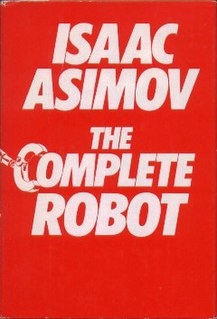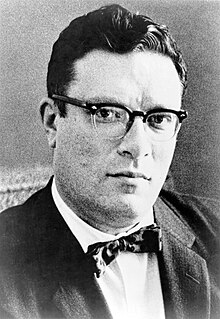
The Three Laws of Robotics are a set of rules devised by the science fiction author Isaac Asimov. The rules were introduced in his 1942 short story "Runaround", although they had been foreshadowed in a few earlier stories. The Three Laws, quoted as being from the "Handbook of Robotics, 56th Edition, 2058 A.D.", are:

The Complete Robot (1982) is a collection of 31 of the 37 science fiction short stories about robots by American writer Isaac Asimov, written between 1939 and 1977. Most of the stories had been previously collected in the books I, Robot and The Rest of the Robots, while four had previously been uncollected and the rest had been scattered across five other anthologies. They share a theme of the interaction of humans, robots and morality, and put together tell a larger story of Asimov's fictional history of robotics. The stories are grouped into categories.

Robot Dreams (1986) is a collection of science fiction short stories by American writer Isaac Asimov, illustrated by Ralph McQuarrie. The title story is about Susan Calvin's discovery of a robot with rather disturbing dreams. It was written specifically for this volume and inspired by the McQuarrie cover illustration. All of the other stories had previously appeared in various other Asimov collections. Four of the stories are robot stories, while five are Multivac stories.
See also: Isaac Asimov bibliography (categorical), Isaac Asimov bibliography (chronological)

"Nightfall" is a 1941 science fiction novelette by American writer Isaac Asimov about the coming of darkness to the people of a planet ordinarily illuminated by sunlight at all times. It was adapted into a novel with Robert Silverberg in 1990. The short story has been included in 48 anthologies, and has appeared in six collections of Asimov's stories. In 1968, the Science Fiction Writers of America voted "Nightfall" the best science fiction short story written prior to the 1965 establishment of the Nebula Awards, and included it in The Science Fiction Hall of Fame Volume One, 1929-1964.

"Sally" is a science fiction short story by Isaac Asimov. It was first published in the May–June 1953 issue of Fantastic and later appeared in the Asimov collections Nightfall and Other Stories (1969) and The Complete Robot (1982).

The Best of Isaac Asimov is a collection of twelve science fiction short stories by American writer Isaac Asimov, published by Sphere IN 1973. It begins with a short introduction giving various details on the stories, such as how they came to be written, or what significance merits their inclusion in a "best of" collection, as well as some of Dr. Asimov's thoughts on a best of collection itself. The stories included are two of his early works, two of his late works (post-1960), and eight from the 1950s, which he refers to as his "golden decade" in the introduction. Except for the last story in the book, "Mirror Image", none of the stories are related to his Robot and Foundation series, while a few mention the Multivac computer.

Nightfall and Other Stories (1969) is an anthology book compiling 20 previously published science fiction short stories by Isaac Asimov. Asimov added a brief introduction to each story, explaining some aspect of the story's history and/or how it came to be written.
"Mirror Image" is a science fiction short story by American writer Isaac Asimov, originally published in the May 1972 issue Analog Science Fiction and Fact, and collected in The Best of Isaac Asimov (1973), The Complete Robot (1982), Robot Visions (1990), and The Complete Stories, Volume 2 (1992).
The first Golden Age of Science Fiction, often recognized in the United States as the period from 1938 to 1946, was an era during which the science fiction genre gained wide public attention and many classic science fiction stories were published. In the history of science fiction, the Golden Age follows the "pulp era" of the 1920s and 1930s, and precedes New Wave science fiction of the 1960s and 1970s. The 1950s are a transitional period in this scheme; however, Robert Silverberg, who came of age in the 1950s, saw that decade as the true Golden Age.
"Segregationist" is a science fiction short story by American writer Isaac Asimov. The story was written in April 1967 and was first published in December in Abbottempo, a magazine produced by Abbott Laboratories, then later included in the collections Nightfall and Other Stories (1969), The Complete Robot (1982) and Robot Visions (1990).
The Complete Stories is a discontinued series intended to form a definitive collection of Isaac Asimov's short stories. Originally published in 1990 and 1992 by Doubleday, it was discontinued after the second book of the planned series. Altogether 86 of Asimov's 382 published short stories are collected in these two volumes.
"Strikebreaker" is a science fiction short story by American writer Isaac Asimov. It was first published in the January 1957 issue of The Original Science Fiction Stories under the title "Male Strikebreaker" and reprinted in the 1969 collection Nightfall and Other Stories under the original title "Strikebreaker". Asimov has stated the editorial decision to run the story as "Male Strikebreaker" "represents my personal record for stupid title changes".

"What Is This Thing Called Love?" is a science fiction short story by American writer Isaac Asimov. The story was requested by Cele Goldsmith Lalli, editor of Amazing Stories, as a satire of an article in Playboy called "Girls of the Slime God" which had suggested that pulp science fiction stories were concerned with aliens and sex. The story appeared in the March 1961 issue of Amazing as "Playboy and the Slime God", but Asimov later retitled it "What Is This Thing Called Love?"
"Breeds There a Man...?" is a science fiction short story by American writer Isaac Asimov. It was first published in the June 1951 issue of Astounding and was reprinted in science fiction anthologies such as Beachheads in Space (1952) and The Great SF Stories #13 (1951), as well as in Asimov-only collections such as Through a Glass, Clearly (1967), Nightfall and Other Stories (1969). and Robot Dreams (1986).
"My Son, the Physicist" is a science fiction short story by American writer Isaac Asimov. It was commissioned by Hoffman Electronics Corporation and appeared in February 1962 in Scientific American. It later appeared in Asimov's collection Nightfall and Other Stories (1969).
"Flies" is a science fiction short story by Isaac Asimov. It was first published in the June 1953 issue of Magazine of Fantasy and Science Fiction, and later appeared in Asimov's collections Nightfall and Other Stories (1969).

The Asimov Chronicles: Fifty Years of Isaac Asimov is a collection of short science fiction stories, mystery stories and science essays by American writer Isaac Asimov, published by Dark Harvest in May 1989.
Depending on the counting convention used, and including all titles, charts, and edited collections, there may be currently over 500 books in Isaac Asimov's bibliography— as well as his individual short stories, individual essays, and criticism. For his 100th, 200th, and 300th books, Asimov published Opus 100 (1969), Opus 200 (1979), and Opus 300 (1984), celebrating his writing.













